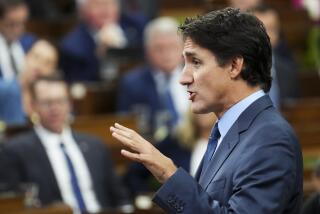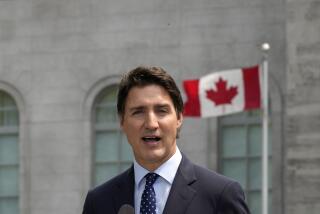Ottawa Moves to Give Its Beleaguered Cultural Image a Boost
- Share via
OTTAWA — “Welcome to Ottawa. Pardon the Inconvenience.” Until a few months ago when the chronic disarray caused by the seemingly endless reconstruction of the Ottawa airport was completed, that was the message on the welcoming sign. Local satirists thought it was an apt, though unintended, expression of the credo of this sleepy little backwater of a national capital.
Not many Canadians love Ottawa or appear to feel that it should become anything more than a necessary evil.
“I think most people who live outside Ottawa see it as a place peopled with fat-cat civil servants with bulletproof jobs,” remarked Bruce Phillips, a longtime Ottawa television correspondent and now Prime Minister Brian Mulroney’s communications director.
Debate Raged
In no arena has the image of Ottawa been more troubled than in that of its cultural life. During the early years of this century, a debate raged here over whether public funds should be spent to build a city library. Dissenters regarded it as a useless luxury. Finally, American steel magnate and philanthropist Andrew Carnegie settled the dispute by making a large bequest for the construction of one, but only on the conditions that the penurious city fathers provide a site and make a modest annual contribution for its growth and upkeep.
The argument over whether there ought to be big federal expenditures to build a monumental home for the nation’s art collection dragged on much longer--101 years, to be exact. During that relatively long period of Canadian history from 1880, when the National Gallery was established, until 1981 when then-Prime Minister Pierre Trudeau, in a mad rush, allocated the funds for a permanent edifice, Canada’s national art treasures bounced around Ottawa like an orphan child.
For a time, Canada’s trove of Monets and Rembrandts was housed in a wing of the Fisheries Ministry building not far from the fish tank displays. It was not the worst of the venues, recalls Jean Sutherland Boggs, a former director of the National Gallery of Canada. “People came in to see both the fish and the paintings.”
Panoramic Views
The dramatic neo-Gothic glass and granite palace for the National Gallery that formally opened in late May, with its panoramic views of the city and the Ottawa River, and the new Museum of Civilization on the opposite bank in the former lumber mill town of Hull, Quebec, which is to be completed next year, are Trudeau’s legacies to this city. And last June, a new structure for the Canadian Museum of Aviation opened.
Trudeau had the novel idea--for the time--that Ottawa could be a center of beauty and culture, a place where visiting Canadians could feel national pride. By erecting new homes for museums on both the French- and the English-speaking sides of the river, which are connected by a footbridge, his aides said, Trudeau hoped to strengthen the fragile bonds that loosely link Canada’s two founding cultures.
“He saw in a sense almost a romantic possibility with these buildings and with the architects’ conception toward these two buildings. He would talk very movingly about this,” said Boggs, whom Trudeau appointed to oversee the efforts to get them started.
Left in Disgust
An internationally respected arts scholar, Boggs had quit as director of the National Gallery in the late 1970s and left Canada in open disgust with Ottawa’s elaborate arts bureaucracy and its repeated failure to live up to promises to build a real national art museum. She taught at Harvard before becoming the director of the Philadelphia Museum. From there, Trudeau called her home.
When she returned, she found to her delight that his hands-on interest abruptly removed the obstacles. After a century of dithering, they spent just seven months looking at sites and interviewing 79 architects before deciding to turn to the then Montreal-based, Israeli-born architect Moshe Safdie to design the art gallery and the Alberta native and part-Canadian Indian architect Douglas Cardinal to draw the plans for the Museum of Civilization. In a “fast track” schedule, excavation began even before final design drawings were complete.
Like native attitudes toward Brasilia, Canberra and, at times, American sentiments toward Washington, Canadians outside Ottawa tend to view their capital with a certain contempt. Ottawa is still redolent of that period in Washington when then-President John F. Kennedy said the American capital combined a certain Southern efficiency with Northern charm. When Canadian Supreme Court Justice Willard Estey retired last month, he made no bones about his joy over leaving Ottawa, which, he said, was “so overloaded with civil servants that . . . it takes 10 just to do the work of one.”
‘I Ain’t Coming Back’
“I have the same feeling as when I left Camp Borden after the war,” the retiring justice told the Toronto Globe and Mail newspaper. “Thank God I came, but I ain’t coming back.”
Located about 300 miles northwest of Boston, Ottawa was selected by Queen Victoria in 1857 after the capital had alternated among Toronto, Montreal and Quebec City. Montreal was abandoned after an angry mob burned down legislative buildings. Queen Victoria never told Canadians why she picked Ottawa. Historians surmise that it was probably because of its distance from the American border. The War of 1812, when the United States invaded Canada, was still a fresh memory, and keeping a safe distance was regarded as prudent.
Ottawa also had the advantage of being on the boundary separating French and English Canada, and thus, presumably, was acceptable to both. But the popular legend had it that the queen was blindfolded when she picked the rough-and-tumble lumber town in a kind of pin-the-tail-on-the-donkey game played on the map of Canada.
A quiet, storybook-pretty little city today, Ottawa, which has a population of 310,000, is distinguished by its stately Gothic architecture and the millions of tulips that bloom in the spring in its parks and along its scenic drives. Its colorful, 150-year-old downtown market district, first settled by builders of the 125-mile Rideau Canal that begins in Ottawa, has been gentrified and is a bustling emporium of vegetable and fruit stalls and specialty food shops.
Pomp and Pageantry
This is a city of some pomp and pageantry. Scarlet-jacketed Royal Canadian Mounted Police on horseback secure Parliament Hill and in the summertime, regiments of another outfit, Canada’s Guards on the Hill, wear bearskin hats, red coats and black trousers and every morning on the broad green lawn in front of the Parliament, perform a changing of the guard ceremony that resembles the ritual held outside Buckingham Palace in London. The Noon Day Gun, a memento of the Crimean War, is fired every day at 12 except on Sundays, when, in deference to church-goers, it is fired at 10 a.m.
But Ottawa is not really a city steeped in any dramatic history of its own. Only in the last generation did it begin to evolve into something other than a musty, little outpost of the British Empire. The most talked about local events of Ottawa’s past are the accidental fires that have raged here, especially the fire that burned down the original Parliament building in 1916. There are war memorials and an eternal flame lit on the occasion of the city’s centennial but the public monuments are mostly modest without any heroics to celebrate. There is a recent statue of a one-legged, cancer-stricken young man who died in a cross-country marathon and an older one of a man who died while unsuccessfully attempting to rescue a drowning girl.
“The city is slowly but certainly sprouting a few cultural wings, but it is not the Athens of the North,” remarked Phillips, Mulroney’s aide. “Like the country itself, we’re slowly emerging from the frontier.”
Determinedly Bilingual City
Ottawa is also Canada’s most determinedly bilingual city, a meeting ground for its two solitudes, a place where anything official is said twice, in both languages. “Welcome to Ottawa, Bienvenue.”
There is little night life here, although there is something of a third rush hour each midnight as Ottawa’s bon vivants flee the slumbering city to Hull across the river where the motels and bars jump until the wee hours. Ottawa does have a National Arts Center near Parliament, which is the home of a chamber orchestra and has facilities for road shows and touring opera companies. Boosters say of Ottawa what boosters always say about quiet, unexciting towns: that it is a great place to bring up children. The children never are given an opportunity to say what they think about that, but one of Trudeau’s ministers did contend when he was forced to be here that “The best thing about Ottawa is the train to Montreal.”
In the Trudeau years, there was a nascent social scene similar to Washington’s that brought together civil servants, journalists and others. It was then that Canada’s current ambassador to Washington, Allan Gotlieb, and his wife, Sondra, the veterans say, honed the act they would take to the American capital. Intimates say they gave little dinner parties and that in a precedent to their later Washington experience, Sondra Gotlieb had on one evening slapped a female dinner guest in the face. But those days are over and Phillips argues that they were never really as glittery as they are now recalled. “Once or twice a year, Trudeau would show up at the National Arts Center with Barbra Streisand . . . hanging out of her dress, and people would talk about the glittery life style in Ottawa.” But the rest of the time, he said, Trudeau practically lived the life of a monk. He said Mulroney entertains more at the prime minister’s residence than Trudeau did but that Mulroney is unwilling to have his parties publicized for fear that his countrymen will begin carping about him leading an imperial life style.
Ottawa’s leading social writer, Charlotte Gray of Canada’s national monthly magazine Saturday Night, demurs. Social life has dwindled and the regard for culture has under the reign of Mulroney’s Progressive Conservative Party become a low priority, she said. While she is excited about the new museums, she is not sure they will radically change things. Trudeau may have succeeded in building this monument but she observed that the budget for new acquisitions has not increased in the last decade, which makes it difficult to compete in the art world for important American and European paintings.
More to Read
The biggest entertainment stories
Get our big stories about Hollywood, film, television, music, arts, culture and more right in your inbox as soon as they publish.
You may occasionally receive promotional content from the Los Angeles Times.










